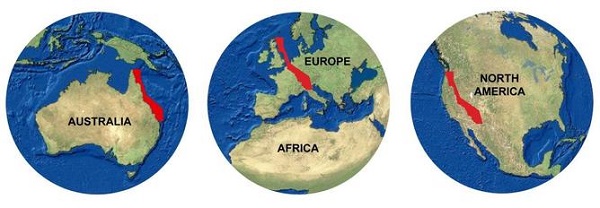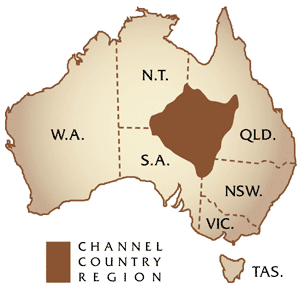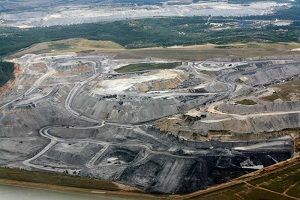This post was written back when the issues of Abbot Point expansion and the dumping of waste in the Great Barrier Reef Marine Park area were current. Now the Queensland Land Court has recommended the State Government reject the multi-billion dollar GVK-Hancock Alpha Coal project in the Galilee Basin. The decision is a non-binding recommendation to the State Government. If they go ahead, conditions have been suggested.
Impact on groundwater was the main concern of local landowners.
It looks to me as though this decision will not in the end impede the construction of the mine. Nevertheless there are concerns also about the economic viability of both the coal mines and the port expansion, as I discuss in the post.
Abbot Point and the Marine Park
Recently the Abbot Point port expansion proposal has caused a great deal of controversy because of the proposed dumping of 3 million tonnes of sludge within the Great Barrier Reef Marine Park area. The contention is that the Great Barrier Reef Marine Park Authority (GBRMPA) initially found against the dumping. In January this year GBRMPA approved the dumping.
Professor Russell Reichelt, chair and chief executive of the Great Barrier Reef Marine Park Authority, makes clear at The Conversation that the material to be dumped is not toxic and while the Authority would prefer placing dredge material on land, “providing it does not mean transferring environmental impact to sensitive wetlands connected to the reef ecosystem”, they are comfortable with the proposed plans.
The material to be dumped is about 60% sand and 40% silt and clay, similar to what you would see if you dug up the site where the material is to be relocated. The target area is a defined 4 square kilometre site free of hard corals, seagrass beds and other sensitive habitats, about 40 kilometres from the nearest offshore reef.
The Marine Park itself is about the size of Italy:

In a comprehensive discussion of the Abbot Point expansion and the Galilee Basin Radio National’s Background Briefing implies that the Abbot Point expansion will not be supervised. The story is told of how in the previous expansion contractor John Holland effectively ignored environmental regulations and was fined a token $195,000 as a result. Professor Reichelt specifies what is to happen this time:
we will have a full-time staff member from GBRMPA located at the port to oversee and enforce compliance during dredge disposal operations. This supervisor has the power to stop, suspend or modify works to ensure conditions are met.
In addition, an independent technical advice panel and an independent management response group will be formed. Membership of both these bodies will need the approval of GBRMPA.
Importantly, the management response group will include expert scientists as well as representatives from the tourism and fishing industries, and conservation groups. Together, GBRMPA and those other independent scrutineers will be overseeing the disposal, and will have the final say — not North Queensland Bulk Ports, which operates Abbot Point, or the coal companies that use the port.
This overview is worth quoting:
Our recent assessments show the dominant risks to the health of the reef are the effects of climate change, excess sediment and nutrient run-off (such as from widespread floods), outbreaks of coral-eating starfish, extreme weather, and some types of fishing.
Coastal development such as ports are assessed as significant but local in their effects.
The effects of climate change.
Watching Greens Senator Larissa Waters debate the Abbot Point expansion with the relevant Qld government minister was like being in an alternate reality. There was no mention of the climate effects of the coal to be exported, no mention of the warming and ocean acidification impact on the reef.
No mention of the impact of the monster mines on the local environment, the use of local aquifers, of the possibility of toxic runoff into the river systems and flood plains the the southwest, the Channel Country and Lake Eyre. As I said last year in Galilee Basin coal: a vision splendid or a kind of madness?:
Water is in fact a considerable issue, as the area has only 400 to 500mm rainfall pa, seasonal and highly variable. Artesian aquifers and water from coal seam gas are being considered. Pastoralists are naturally worried as are environmentalists. The area can be subject to heavy rains which ends up with a toxic brew from open-cut mines being pumped into water courses. The basin drains towards Lake Eyre, (now officially known as Kati Thanda–Lake Eyre).
This image is from an organic beef producer and their enthusiasm has expanded the area to include the whole Simpson’s Desert, but it gives an idea of the part of the country we are talking about:

Moreover the railway line or lines will cut across grazing lands on expansive flood plains, making water movement highly problematic with heavy rain.
Economics of the mining projects
Mercifully both projects look wildly uneconomic. The Background Briefing story quotes a UBS commodities analyst who says that for the Galilee Basin to be profitable the coal price would have to be around AU$110 per tonne. Their long term estimate is $80 per tonne. The program saw India rather than China as being the most prospective customer. India is running out of coal that can be mined, but the current price there is about $23 per tonne (I presume US$). They need electricity for hundreds of millions who rely on wood or cow dung for cooking and heating, but not at any price.
John Quiggin has two posts about companies pulling out and the shaky economics of both projects:
Following a similar announcement last week by Lend Lease, and earlier announcements by BHP Billiton annd Rio Tinto, mining company Anglo American has withdrawn its proposal to take part in the expansion of the Abbot Point coal terminal. That leaves only two proposals, both from Indian companies owned by billionaire entrepreneurs reminiscent of Bond, Skase and other Australian heroes of the 1980s. Both Adani and GVK are heavily indebted conglomerates of the type that invariably emerge when money is cheap, and mostly collapse when the tap is turned off.
It’s not surprising that these companies have not yet abandoned their bids. Doing so would involve booking huge losses on their mining prospects in the Galilee Basin. But, it’s hard to believe anyone is going to lend them the billions required, not just for the port expansion, but for a 500km rail line and the mine itself. The price of coal is well below the level required to cover the costs of extraction and transport, let alone to provide a return on capital. And if Adani and GKV don’t build the rail lines, the development of the entire Basin will grind to a halt.
Here’s hoping!
Update: Mark Colvin discusses the economics of the mine with the ABC’s business editor Ian Verrender, confirming concerns.


The description of that proposed marine dump site sounds wonderful; how could anyone disagree with such a reasonable proposal? Well, me for a start. What about currents? Seas do tend to have currents – currents that can carry turbid water for hundreds of Kilometres and can have nasty effects on marine life along the way. What about human nature, laziness, greed and sheer pigheadedness? They say the dredged material will be dumped in the specified 4 square Kilometre target area – every time? Yeah. Right. Of course. Both the Easter Bunny and Santa Claus agree that the material will be dumped there every time – and Puss-In-Boots agrees with them too.
In my neck of the woods ( Mackay ) the charter boats target the ” spoil/toxic sludge/ dump sites ” for the good fishing.
We must understand that %99 of the sea floor between the coast and the GBR is devoid of fish.
Outside the prawn fields ( very near the coast ) it’s just miles and mile of flat nothing.
Create a bump with anything, ( a wreak, sunk shipping container, a barge of old tyres ) and the turbulence yields a point for a for a new reef to start.
Hay Point dredge dump areas have actually eased the recreational fishing pressure on the outer reef for over 30 years.
[ i must admit to 40 years as both a recreational and professional fisherman in these parts ]
Having said that, if knickers are still twisted, the northern coal fields had about 100 million tonne capacity of empty wagons returning to big holes in the ground in 2013.
Jumpy, hope you are not thinking of filling in potentially useful whopping big holes, are you? The farce of mines rehabilitation might yet be turned to good purpose – purely by accident; certainly not by any enforcement of obligations nor by careful planning, that’s for sure.
You are right about creating new fish habitats. Perhaps even an artificial island – such as the old Bishop Island at the mouth of the Brisbane River – might be the way to go.
However, in today’s climate of open slather for any big business or pseudo-investor and to hell with public benefit or future generations, I still have very serious doubts about the dredged material always being dumped in the designated place. Regulations and stern penalties? We’ve all seen the tuppenny fines and the floggings with a feather, haven’t we?
Further, fish have to eat something, hence my comment above about turbidity – it’s all the stuff smaller than 20 microns in the silt component of the dredged material that is the worry, it does not have to be toxic at all to cause serious trouble. As a keen fisherman, you’ve seen for yourself what a double-edged sword river flooding can be; this will be day-in-day-out so although the amount of suspended and dissolved material may be less, in a given year, than a river flood, it will be continuous and its effects won’t dissipate within a couple of weeks as do those of a river flood.
As for the need to open yet another big coal mine, that has more to do with the hectic gambling in the Other Casino (stock exchange) that with any rational economic decision-making. Don’t forget that India has been a overt nuclear power since 1970 – once the dust of elections has settled, I expect to see several cutting-edge, relatively low-cost, fairly safe, small-scale nuclear power stations being built in India (Windscale, Three-Mile island, Chernobyl and Fukushima are now ancient history for the Indians – they’ve learnt from those terrible lessons ). So what price for Australian coal in 2017 and 2018?
My main objections to the Galilee basin development are:
1. We should be ramping down coal production, not opening a new coal province.
2. We shouldn’t be wasting government money on subsidies, infrastructure and royalty concessions aimed at encouraging a start-up that probably won’t happen.
Unless I am missing something the rest of the arguments seem marginal and may be counter productive. For example, in the context of the enormous Lake eyre catchment,
seems a little far fetched, both in terms of the toxicity of the brew and potential impact.
Graham Bell
Good points but I think your fear on turbidity and monitoring may be eased.
Firstly Hay Point and Dalrymple Bay have been dredging/dumping for 30 years with no harm, to my knowledge.
With tides of 7m here and half that at Abbott point the “plume ” would be more contained not less.
Even so, the ” plume ” would be highly visible from the air and with Customs planes flying over twice a day on their ” catch a naughty fisherman in the restricted zones ” game I’m sure a photo or two with GPS data ( standard ) can be used in court. Weather satellite photos another.
Look, I get it, there are folks committed to stoping coal exports ( here ) and that could be justifiable but… and a big BUT.., to use dredging as a reason isn’t.
It’s going to happen. If people truly care for the GBR then work with it.
Perhaps mark out the dump site with old tyre stacks in cooperation with the project management and create a fishing Mecca within 5 coral spawning.
It’s an opportunity.
BHP is looking to hive off its thermal coal assets because it doesn’t help the company image and it will be a big drag on profit growth.
Can’t see BHP or any other professional mining company rushing to risk money on anything to do with the Galilee basin.
Yes John D, I think the finance industry may have the last say on the Galilee Basin. Gina sold most of her stake, Clive not so lucky.
On Abbot Point it’s a hard call to say that Professor Reichelt is a dill or bent or something, but again the economics look fanciful.
Having read Professor Reichelt’s post, (and all comments there), my reservations about the dumping and associated approval process remain.
My primary concern with respect to the dispersal of the “fines” from the dumping process remains – and is strengthened by the comments of researchers on that thread, stressing that such dispersal will occur, is uncontrollable, and that its effects will be measurable to the margins of the outer reef.
It was also pointed out that the nature of the spoil is not nearly as benign as the Professor implies,
Firstly, Abbot Point is already a coal port, and the local area is already polluted with coal dust from loading and storage activities,
Secondly, the nature of the toxicity testing was apparently confined to “first order” chemicals, but neglected recombinants, I believe that is pretty standard procedure, but recognise the possibility that whilst toxic “precursor” chemicals may not be present in test samples, their by- products may be.
I don’t think the Professor is a dill, or bent, rather (giving benefit of the doubt), is trying to deal as gest he is able, with an invidious set of circumstances not of his making.
Just on toxic solutes. Pterosaur, I saw a nice example of scientific propaganda a few years back. An “analysis” of a suspect body of water referred to the totals of elemental contaminates, it did not refer to the various salts of those elements – some of which were bioavailable and present. Is it any wonder I am now sceptical of all analyses, even if they were performed by angels, cherubim and seraphim.
Pterosaur @ 8, thanks for that. I didn’t read the comments thread to see whether Reichelt was home free. Yep, I should have.
In the end, though, financial risk should save the day. The Qld govt wants to press ahead, believing the glory days of coal will return.
While the Queensland government and the gamblers on the stock-exchange casino waste their time waiting for the glory days of coal to return, they are losing opportunities and precious time seeking new ways of gaining revenue and profits.
The Cargo Cult of the South Pacific has an understandable basis for the beliefs of its followers …. in stark contrast, the “cargo cult” of the Queensland government and of many large firms is completely irrational. If you are a shareholder in any such firms, sell now; cut your losses and run before you lose any more money.
One of the key points made by Prof Reichelt was that the reef has deteriorated dramatically over the last 50 yrs and that we should be doing something about that instead of going on about something that he says will have not much effect at all in the scheme of things.
While the GBR has certainly deteriorated over the last 50 years, much of the damage has been the result of ignorance as to the nature of the GBR ecosystem.
This ecosystem extends from the coastal complexes through to the outer reef, and probably to the drainage systems feeding water (+ contaminants) eastward to the coast.
The point being that physical and biological systems throughout the reef complex are linked and interdependent in such a fashion that “localised” events may, and do have widespread effects.
The Prof.’s assertion that
speaks to me of a false dichotomy, – surely in the light of present knowledge,
we can do better?